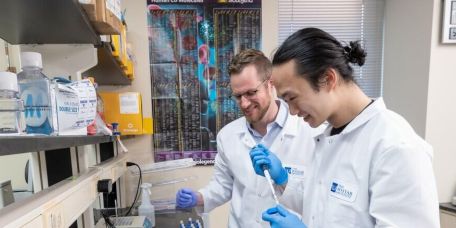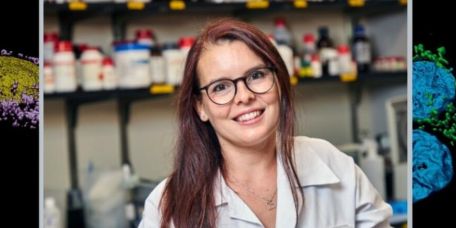The Wistar Institute
How Does our Immune System Respond to Vaccines?
A Q&A with Wistar’s Dr. Amelia Escolano What got you interested in immunology? My interest in immunology started in college. I took several immunology courses, and I was particularly attracted by antibody biology. One of these cou…
From Lab to Laptop: The Interdisciplinary World of Computational Biology
Wistar’s Dr. Avi Srivastava seamlessly integrates elements of computer science and traditional biology into his new computational biology research lab. By combining wet and dry lab approaches — experimental biology and computational data — he can be…
Wistar Scientists Engineer New NK cell Engaging Immunotherapy Approaches to Target and potentially Treat recalcitrant Ovarian Cancer
PHILADELPHIA—(Nov. 1, 2023)— The Wistar Institute’s David B. Weiner, Ph.D., executive vice president, director of the Vaccine & Immunotherapy Center (VIC) and W.W. Smith Charitable Trust Distinguished Professor in Cancer Research, and collaborat…
Jesper Pallesen, MBA, Ph.D.
Assistant Professor, Vaccine & Immunotherapy Center
Notes from the Field: Dr. Ian Tietjen in Africa, Part 5
Dr. Ian Tietjen is a Research Assistant Professor in Wistar’s Montaner Lab, where he investigates traditional African medicinal compounds’ potential for drug origination against viruses like HIV. Dr. Tietjen travels to Africa to work with traditiona…
Dean Stoios Joins The Wistar Institute as Chief Financial Officer
PHILADELPHIA (October 17, 2023) – The Wistar Institute, a global leader in biomedical research in cancer, immunology and infectious diseases, announces the appointment of Dean Stoios as Chief Financial Officer. “We are thrilled to welcome Dean to Wi…
Notes from the Field: Dr. Ian Tietjen in Africa, Part 4
Dr. Ian Tietjen is a Research Assistant Professor in Wistar’s Montaner Lab, where he investigates traditional African medicinal compounds’ potential for drug origination against viruses like HIV. Dr. Tietjen travels to Africa to work with traditiona…
Wistar Institute HIV Researcher Wins Two Grants to Explore Using CAR T Cells as HIV Therapy
Dr. Daniel Claiborne of The Wistar Institute was recently awarded two grants to support studying an approach to optimize CAR T cells, a type of engineered cell, for use against HIV. Claiborne, a Caspar Wistar Fellow in Wistar’s Vaccine & Immunot…
Wistar Trainees Celebrate Postdoc Appreciation Week with Trivia Showdown
See if you can beat the winning team at the end of the article! The air is electric with excitement and trepidation. Ph.D. students, research assistants, and postdoctoral fellows alike have gathered in The Wistar’s Grossman Auditorium for one of the…
EVs Drive Cancer. A Wistar Scientist Wants to Know How
Dr. Irene Bertolini of the Altieri Lab investigates extracellular vesicles and their role in metastasis When cancer spreads, cancer kills. Cancer’s ability to spread to other parts of the body — a process known as metastasis — makes the disease dang…









